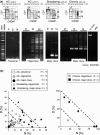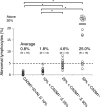Advanced human T-cell leukemia virus type 1 carriers and early-stage indolent adult T-cell leukemia-lymphoma are indistinguishable based on CADM1 positivity in flow cytometry
- PMID: 25703103
- PMCID: PMC4452161
- DOI: 10.1111/cas.12639
Advanced human T-cell leukemia virus type 1 carriers and early-stage indolent adult T-cell leukemia-lymphoma are indistinguishable based on CADM1 positivity in flow cytometry
Abstract
We previously reported that the cell adhesion molecule 1 (CADM1) versus CD7 plot in flow cytometry reflects disease progression in human T-cell leukemia virus type 1 (HTLV-1) infection. In CD4(+) cells from peripheral blood, CADM1(-) CD7(+) (P), CADM1(+) CD7(dim) (D) and CADM1(+) CD7(-) (N) subpopulations are observed. The D and N subpopulations increase as asymptomatic HTLV-1 carriers (AC) progress to indolent adult T-cell leukemia-lymphoma (ATL) and the N subpopulation then expands in aggressive ATL. In the present study we examined whether the analysis can estimate the risk of developing ATL in advanced AC. Peripheral blood samples from AC (N = 41) and indolent ATL patients (N = 19) were analyzed by flow cytometry using the CADM1 versus CD7 plot for CD4(+) cells and inverse long PCR (clonality analysis) of FACS-sorted subpopulations. Almost all AC with a high HTLV-1 proviral load (>4 copies/100 cells) had a CADM1(+) (D + N) frequency of >10%. AC with 25% < CADM1(+) ≤ 50% contained expanded clones similar to smoldering-type ATL. In many patients in the 25% < CADM1(+) ≤ 50% group, the proportion of abnormal lymphocytes was distributed around the 5% line, which divides AC and smoldering-type ATL in Shimoyama's classification. In conclusion, the CADM1 versus CD7 plot is useful for selection of putative high-risk AC. The characteristics of some AC and smoldering ATL are said to be similar; however, long-term follow up is required and the clinical outcome (e.g. rate of transformation) of these cases should be used to determine whether to include them in the same clinical category.
Keywords: Adult T-cell leukemia-lymphoma; CADM1 protein; CD7 antigen; HTLV-1; flow cytometry.
© 2015 The Authors. Cancer Science published by Wiley Publishing Asia Pty Ltd on behalf of Japanese Cancer Association.
Figures




Similar articles
-
CADM1 expression and stepwise downregulation of CD7 are closely associated with clonal expansion of HTLV-I-infected cells in adult T-cell leukemia/lymphoma.Clin Cancer Res. 2014 Jun 1;20(11):2851-61. doi: 10.1158/1078-0432.CCR-13-3169. Epub 2014 Apr 11. Clin Cancer Res. 2014. PMID: 24727323
-
The CD3 versus CD7 plot in multicolor flow cytometry reflects progression of disease stage in patients infected with HTLV-I.PLoS One. 2013;8(1):e53728. doi: 10.1371/journal.pone.0053728. Epub 2013 Jan 22. PLoS One. 2013. PMID: 23349737 Free PMC article.
-
CD4+ CADM1+ cell percentage predicts disease progression in HTLV-1 carriers and indolent adult T-cell leukemia/lymphoma.Cancer Sci. 2019 Dec;110(12):3746-3753. doi: 10.1111/cas.14219. Cancer Sci. 2019. PMID: 31642546 Free PMC article.
-
CADM1/TSLC1 is a novel cell surface marker for adult T-cell leukemia/lymphoma.J Clin Exp Hematop. 2012;52(1):17-22. doi: 10.3960/jslrt.52.17. J Clin Exp Hematop. 2012. PMID: 22706526 Review.
-
Human T lymphotropic virus type-I and adult T-cell leukemia in Japan.Int J Hematol. 2002 Aug;76 Suppl 2:240-5. doi: 10.1007/BF03165123. Int J Hematol. 2002. PMID: 12430931 Review.
Cited by
-
Evaluation of ALKBH2 and ALKBH3 gene regulation in patients with adult T-cell leukemia/lymphoma.Virol J. 2024 Dec 4;21(1):316. doi: 10.1186/s12985-024-02590-w. Virol J. 2024. PMID: 39633427 Free PMC article.
-
A comprehensive assessment using multiple factors based on HAS-Flow analysis predicts ATL development and progression.Sci Rep. 2025 Jul 22;15(1):26618. doi: 10.1038/s41598-025-10822-4. Sci Rep. 2025. PMID: 40695942 Free PMC article.
-
HAS-Flow May Be an Adequate Method for Evaluating Human T-Cell Leukemia Virus Type 1 Infected Cells in Human T-Cell Leukemia Virus Type 1-Positive Rheumatoid Arthritis Patients Receiving Antirheumatic Therapies: A Retrospective Cross-Sectional Observation Study.Viruses. 2023 Feb 8;15(2):468. doi: 10.3390/v15020468. Viruses. 2023. PMID: 36851682 Free PMC article.
-
Clinical significance of soluble CADM1 as a novel marker for adult T-cell leukemia/lymphoma.Haematologica. 2021 Feb 1;106(2):532-542. doi: 10.3324/haematol.2019.234096. Haematologica. 2021. PMID: 32054656 Free PMC article.
-
Mortality and risk of progression to adult T cell leukemia/lymphoma in HTLV-1-associated myelopathy/tropical spastic paraparesis.Proc Natl Acad Sci U S A. 2020 May 26;117(21):11685-11691. doi: 10.1073/pnas.1920346117. Epub 2020 May 11. Proc Natl Acad Sci U S A. 2020. PMID: 32393644 Free PMC article.
References
Publication types
MeSH terms
Substances
LinkOut - more resources
Full Text Sources
Other Literature Sources
Research Materials
Miscellaneous

